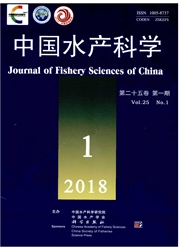

 中文摘要:
中文摘要:
为了筛选草鱼肝细胞脂肪变性的最佳诱导剂及浓度,并初步分析脂肪乳剂(lipid emulsions, LE)引起草鱼肝细胞脂肪变性的作用机理,以草鱼(Ctenopharyngodon idellus)正常肝细胞为研究对象,建立草鱼脂肪变性肝细胞模型,以含10%胎牛血清的基础培养液为对照组,处理组为含20%脂肪乳剂0.5~2 mL/L和含20%、50%胎牛血清的诱导培养液,孵育草鱼肝细胞48 h 后,定量分析肝细胞内的甘油三酯(TG)含量,观察脂滴积聚情况及肝细胞超微结构的变化,检测细胞培养上清中谷丙转氨酶(alanine transaminase, ALT)、谷草转氨酶(aspartate transaminase, AST)的活性, qRT-PCR技术检测脂代谢关键基因(PPARa、PPARg、SREBP-1c、LPL、Lep和UCP2)的转录水平变化,蛋白质印迹技术检测PPARg、SREBP-1c的蛋白水平变化。结果发现,含1~2 mL/L LE的诱导液组和含20%、50%FBS的诱导液组与对照组相比TG含量均显著上升(P〈0.05),且20%FBS和各浓度LE诱导组的转氨酶活性与对照组相比差异不显著(P〉0.05),表明含1~2 mL/L LE的诱导液和含20% FBS的诱导液均可建立草鱼营养性脂肪肝细胞模型。在肝细胞脂变模型中, PPARγ和 LPL 等脂代谢基因的表达量显著升高(P〈0.05),而 Lep 基因表达量显著降低(P〈0.05), PPARγ和SREBP-1c的蛋白水平升高。结论认为:采用1~2 mL/L LE和20%的FBS均可以在短时间内建立草鱼肝细胞脂肪变性模型,含1 mL/L LE的诱导液诱导效果最佳;肝细胞内脂质的蓄积可能与脂肪代谢关键基因PPARγ、SREBP-1c、LPL及Lep等密切相关。
 英文摘要:
英文摘要:
To establish a model of grass carp (Ctenopharyngodon idellus) hepatocyte steatosis and investigate a possible mechanism for lipid emulsion (LE)-induced steatosis in grass carp hepatocytes, normal grass carp hepa-tocytes were cultured in different inducing media supplemented with different concentrations of LE or fetal bovine serum (FBS). LE and FBS were tested to identify the best medium and optimal concentration. Grass carp hepato-cytes were cultured in inducing medium containing 20%or 50%FBS, or different concentrations (0.5–2 mL/L) of clinical vein nutrition drug (20% LE) for 48 h. Lipid accumulation was observed by phase-contrast microscopy, the ultrastructure of fatty degeneration of hepatocytes was observed by transmission electron microscope, the triglyceride (TG) content was determined by Oil red O extraction, the activity of ALT and ASL enzyme were ex-amined biochemically, and the expression of the lipid metabolism genes PPARa, PPARg, SREBP-1c, LPL, Lep and UCP2 was determined by real-time PCR. The results revealed that a model of grass carp hepatocyte steatosis can be established using induction medium containing 1–2 mL/L LE, or 20%FBS. The TG level was greatly increased in cells treated with 1–2 mL/L LE, and 20%or 50%FBS compared with that of the control cells (P〈0.05). How-ever, there was no significant difference in the aminotransferase activity between cells treated with 20%FBS and cells treated with various concentrations of LE(P〉0.05). In the model of grass carp hepatocyte steatosis, expres-sion of PPARgand LPL genes significantly increased(P〈0.05), while Lep gene expression decreased sharply (P〈0.05). In conclusion, our grass carp hepatocyte steatosis model was established over a short time using 1–2 mL/L LE or 20% FBS. Lipid accumulation in hepatocytes was closely related to the expression of lipid metabolism genes (PPARs, SREBP-1c, LPL and Lep). This study provides the foundations for developing an animal model to explore nutrient meta
 同期刊论文项目
同期刊论文项目
 同项目期刊论文
同项目期刊论文
 Identification, organ expression and ligand-dependent expression levels of peroxisome proliferator a
Identification, organ expression and ligand-dependent expression levels of peroxisome proliferator a Complete mitochondrial genome of the blind cave barbel Sinocyclocheilus furcodorsalis (Cypriniformes
Complete mitochondrial genome of the blind cave barbel Sinocyclocheilus furcodorsalis (Cypriniformes Isolation and Characterization of Novel Genomic and EST-SSR Markers in Coreoperca whiteheadi Bouleng
Isolation and Characterization of Novel Genomic and EST-SSR Markers in Coreoperca whiteheadi Bouleng Isolation and characterization of fifteen novel microsatellite loci in golden mandarin fish (Siniper
Isolation and characterization of fifteen novel microsatellite loci in golden mandarin fish (Siniper Insights into food preference in hybrid F1 of Siniperca chuatsi (♀)× Siniperca scherzeri (♂) mandari
Insights into food preference in hybrid F1 of Siniperca chuatsi (♀)× Siniperca scherzeri (♂) mandari Effects of Polymorphisms in Pepsinogen (PEP), Amylase (AMY) and Trypsin (TRY) Genes on Food Habit Do
Effects of Polymorphisms in Pepsinogen (PEP), Amylase (AMY) and Trypsin (TRY) Genes on Food Habit Do Differential gut growth, gene expression and digestive enzyme activities in young grass carp (Ctenop
Differential gut growth, gene expression and digestive enzyme activities in young grass carp (Ctenop Phylogeography of Coreoperca whiteheadi (Perciformes: Coreoperca) in China based on mitochondrial an
Phylogeography of Coreoperca whiteheadi (Perciformes: Coreoperca) in China based on mitochondrial an Isolation and characterization of 31 polymorphic microsatellite markers in Siniperca obscura Nichols
Isolation and characterization of 31 polymorphic microsatellite markers in Siniperca obscura Nichols Effects of glucose, insulin and triiodothyroxine on leptin and leptin receptor expression and the ef
Effects of glucose, insulin and triiodothyroxine on leptin and leptin receptor expression and the ef Effects of lipid-lowering pharmaceutical clofibrate on lipid and lipoprotein metabolism of grass car
Effects of lipid-lowering pharmaceutical clofibrate on lipid and lipoprotein metabolism of grass car Effects of dietary non-protein energy source levels on growth performance, body composition and lipi
Effects of dietary non-protein energy source levels on growth performance, body composition and lipi Effects of vitamin E on growth performance and antioxidant status in juvenile grass carp Ctenopharyn
Effects of vitamin E on growth performance and antioxidant status in juvenile grass carp Ctenopharyn Feed intake, feed utilization and feeding-related gene expression response to dietary phytic acid fo
Feed intake, feed utilization and feeding-related gene expression response to dietary phytic acid fo Effect of dietary glutathione supplementation on the biological value of rapeseed meal to juvenile g
Effect of dietary glutathione supplementation on the biological value of rapeseed meal to juvenile g Identification of SNPs in NPY and LEP and the association with food habit domestication traits in ma
Identification of SNPs in NPY and LEP and the association with food habit domestication traits in ma Single Nucleotide Polymorphisms in Growth Hormone Gene and Their Association with Growth Traits in S
Single Nucleotide Polymorphisms in Growth Hormone Gene and Their Association with Growth Traits in S The role of leptin in lipid metabolism in fatty degenerated hepatocytes of the grass carp Ctenophary
The role of leptin in lipid metabolism in fatty degenerated hepatocytes of the grass carp Ctenophary Neuropeptide Y stimulates food intake and regulates metabolism in grass carp, Ctenopharyngodon idell
Neuropeptide Y stimulates food intake and regulates metabolism in grass carp, Ctenopharyngodon idell Development and characterization of twenty-nine novel polymorphic microsatellite loci in the mandari
Development and characterization of twenty-nine novel polymorphic microsatellite loci in the mandari Isolation and characterization of twenty-five polymorphic microsatellite markers in Siniperca scherz
Isolation and characterization of twenty-five polymorphic microsatellite markers in Siniperca scherz 期刊信息
期刊信息
